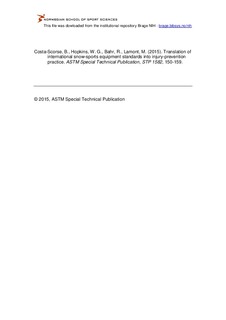| dc.contributor.author | Costa-Scorse, Brenda A. | |
| dc.contributor.author | Hopkins, Will G. | |
| dc.contributor.author | Bahr, Roald | |
| dc.contributor.author | Lamont, Mike | |
| dc.date.accessioned | 2016-08-29T11:14:47Z | |
| dc.date.available | 2016-08-29T11:14:47Z | |
| dc.date.issued | 2015-07 | |
| dc.identifier.citation | ASTM Special Technical Publication. 2015, STP 1582, 150-159. | nb_NO |
| dc.identifier.uri | http://hdl.handle.net/11250/2402446 | |
| dc.description | © 2015, ASTM Special Technical Publication | |
| dc.description.abstract | International industry standards set out requirements to mount ski bindings, test equipment functionality, provide guidelines on how to maintain the ski-binding-boot interface, and calculate correct release values. The standards call for the use of a torque testing device to assess functionality of the ski-binding with release values based on parameters of age, weight, height, boot-sole length, and skier type. To determine whether these standards were being applied in New Zealand a cross-sectional study was completed with a national survey of ski technicians and structured interviews with senior ski industry personnel. In setting up ski bindings, only 10 % of ski technicians used a torque-testing device, and substantial proportions did not take into account appropriate skier characteristics or check the boot–binding interface. Interviews of senior personnel indicated that there was good intent about quality of rental service; however, there were inconsistencies between operating procedures and international standards. The interviews also highlighted a need for better standardized questioning techniques for ski technicians to accurately determine skier type, and increased education for both ski technicians and skiers on correct setup to prevent injury related to non-release or inadvertent release. In conclusion, Ski-Binding-Boot (SBB) system inspection, routine torque testing to ensure safe functional ski-bindings, and consistent application of the international standards for correct setup of ski-binding-boot systems continues to be elusive in New Zealand. Assessment of the implementation of the international standards in other countries is also needed. | nb_NO |
| dc.language.iso | eng | nb_NO |
| dc.publisher | ASTM International | nb_NO |
| dc.subject | alpine skiing | nb_NO |
| dc.subject | equipment | nb_NO |
| dc.subject | standards | nb_NO |
| dc.subject | ski-binding-boot system | nb_NO |
| dc.subject | torque | nb_NO |
| dc.subject | injury | nb_NO |
| dc.title | Translation of international snow-sports equipment standards into injury-prevention practice | nb_NO |
| dc.type | Journal article | nb_NO |
| dc.type | Peer reviewed | nb_NO |
| dc.subject.nsi | VDP::Technology: 500::Materials science and engineering: 520 | nb_NO |
| dc.source.journal | ASTM Special Technical Publication | nb_NO |
| dc.identifier.doi | 10.1520/STP158220140009 | |
| dc.description.localcode | Seksjon for idrettsmedisinske fag / Department of Sports Medicine | nb_NO |
